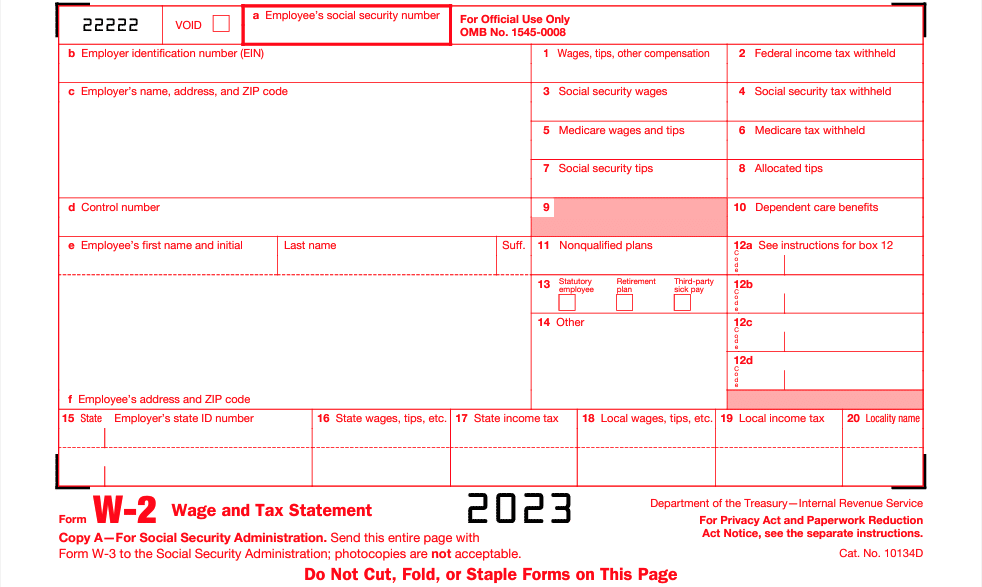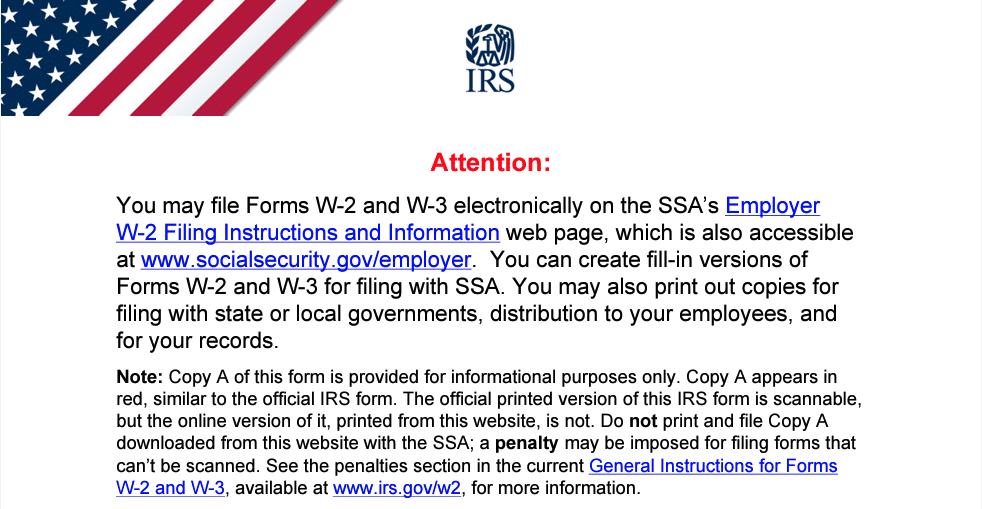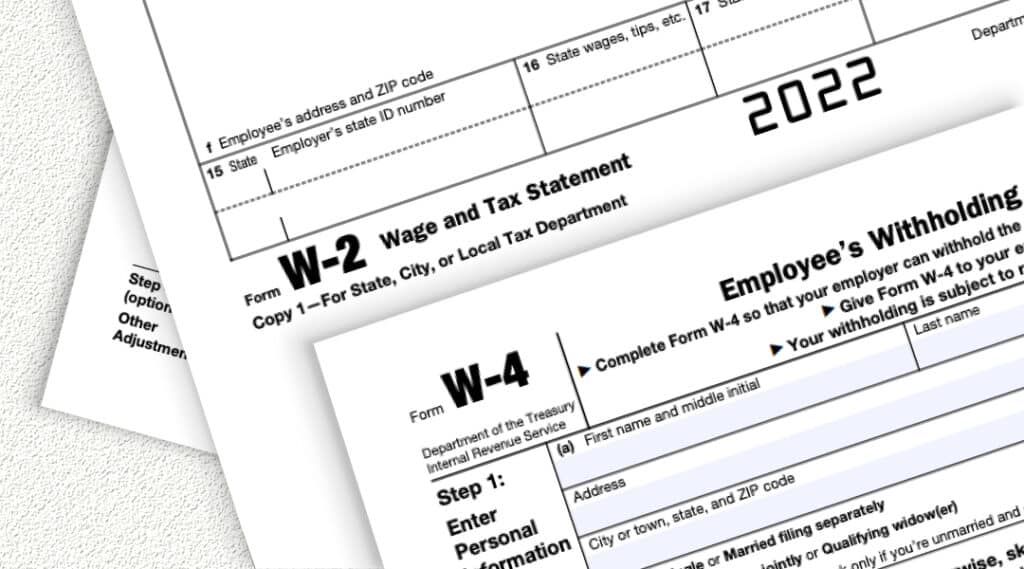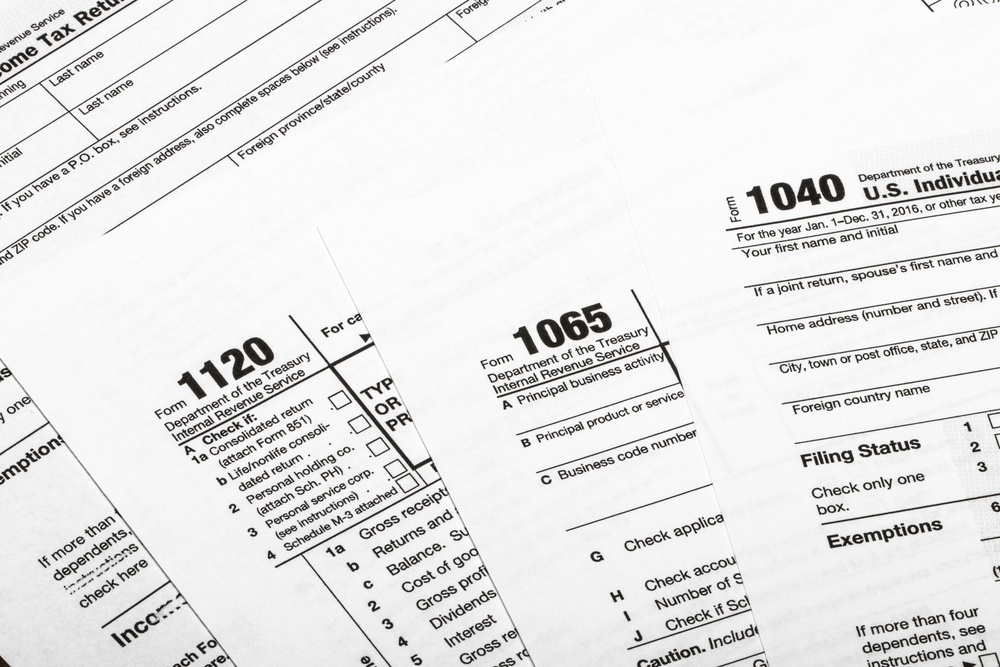Here’s the truth. Being lax with your taxes can be catastrophic as a business owner or an individual.
And one area of tax regulation that’s particularly unforgiving about mistakes is payroll taxes. Missing some due dates by as little as 30 days could cost a small business as much as $220,500 per year.
Employees complete Form W-4 to guide employers in calculating how much tax to withhold from the employee’s paycheck.
On the other hand, employers issue W-2s to their employees as a report of what they earned—and the taxes the employee paid—in a given year.
In this article, we’ll delve into the details regarding Forms W-2 and W-4, discussing their meaning, when and how to file them, and their key differences.
What is Form W-4?
An employee completes Form W-4 to provide their employer with information about their tax circumstances. This information is what an employer will use to determine how much tax to withhold from the worker’s paycheck.

Source: IRS.gov
What’s the purpose of Form W-4?
Form W-4 helps an employer determine the amount of federal income tax to withhold from an employee’s paycheck.
Think about it this way. Your employer doesn’t know how much tax you’ll owe. So you need to tell them by completing a W-4.
This is because, aside from your income level, other personal information determines the amount of tax you should pay.
For instance, your employer doesn’t know if you have dependents. And according to the tax code, having dependents provides certain tax breaks.
How to complete Form W-4
There are five sections in Form W-4. Of course, depending on an individual’s situation, some sections may not be applicable and can be safely left unfilled.
1. Personal information
Workers should fill out basic personal information under this section. These include name, address, Social Security number, and information on tax filing status.
2. Multiple jobs or a working spouse
This section should be filled in only by individuals with more than one job.
Along with multiple job holders, anyone married to working spouses and filing jointly should also review this section.
3. Dependent information
This section applies to those with qualifying children or other dependents.
The IRS defines qualifying children based on a 4-test criterion, including age, residency, relationship, and whether the child you claim has filed a joint return. You can learn more about the qualifying child test from the IRS website.
It’s also important to note that those who’ll benefit from tax credits for having qualifying children or other dependents are only those earning less than $200,000 ($400,000 for joint filers).
4. Other adjustments
This section applies to workers who want their employer to withhold a higher or lower amount based on what they ultimately expect to earn. So workers who anticipate some passive income, like dividends, should fill out this section.
The same applies to workers who may want to claim deductions other than the standard deduction.
For these additional deductions, workers can use the deductions worksheet that comes with the form to help with the calculation.
5. Signature and date
This is the shortest part. Employees need to sign and date the form.
Aside from Step 1, this is the only other mandatory section to complete.
You can find blank W-4s on the IRS website.
Other important points to consider when filling out Form W-4
There are other important factors to consider in filling out a W-4, including when to complete it and what happens afterward.
When to complete Form W-4
Employees should fill out a W-4 when starting a new job as a part of the new hire paperwork. And a new W-4 should be completed if the employee has a life-changing event that may impact their tax liability.
Some of these triggering events could be a change in marital status or the birth of a child. But the truth is, employees can complete new W-4s whenever they like.
Employer’s involvement with Form W-4
After an employee has filled out the W-4, the employer now comes into the picture.
Keep in mind that employers are not allowed to help workers complete Form W-4. But they offer resources to help determine the correct withholding amount.
The employer’s role is limited to entering the employee’s date of employment, the company’s EIN (Employer Identification Number), and address.

Source: IRS.gov
The IRS doesn’t require employers to submit W-4s to them, unless in certain circumstances when they request it from the company. That means the employer’s HR office is Form W-4’s last home.
Your payroll department will input the information provided on the W-4 into your payroll software to calculate your staff’s paychecks.
And it’s also important to note that your state may require a state withholding form to help calculate how much state income tax to withhold from workers’ pay.
You can check with your state’s revenue department to confirm withholding form requirements.
Let’s now shift gears to Form W-2.
What you need to know about Form W-2
Also known as the Wage and Tax Statement, a W-2 is a form issued by the employer to employees, the Social Security Administration (SSA), and state and local tax authorities detailing information about how much the individual worker earned in a year.
Caveat: You don’t have to send copies of W-2s to the IRS because the SSA will share the federal tax information with them.
Along with showing wages earned, the W-2 shows each employee’s tax withholding for the year.
Who gets a Form W-2
According to IRS, employers are generally only required to issue W-2s to workers who earn $600 or more in a calendar period. But if any tax is withheld, even if less than $600 was earned, a W-2 needs to be created.
And W-2s are only provided to employees, not independent contractors who receive Forms 1099-NEC or 1099-MISC, depending on the type of service they provide.

Source: IRS.gov
What’s the purpose of Form W-2?
Here’s the truth. W-2s are not just meant to make your life needlessly hard.
These are some of the reasons W-2s are useful.
- As a worker, it helps you file your annual tax returns. Without it, workers may have to rely on their (undependable) memory or on several individual documents like payslips to report all their earnings and taxes withheld.
- Form W-2 helps the SSA calculate the benefits that a worker is entitled to. These include retirement, disability, and survivor benefits.
- Lastly, the taxman (IRS) uses the W-2 to ensure everyone reports their income correctly.
Information included on Form W-2
Form W-2 has five copies. For each employee, you’ll have five copies of the same information because many people need this information.
The different copies of Form W-2 are:
- Copy A – Provided to the SSA, and it must be printed with special red ink that makes it scannable by the SSA. You’ll need to buy blank W-2 packages from office supply stores or reputable online sources if you don’t file electronically.

Source: IRS.gov
- Copy B – Provided to the employee (for use with federal tax return)
- Copy C – Provided to the employee (for employee’s records)
- Copy D – Kept for employer’s records
- Copy 1 – Provided to state or local tax department
- Copy 2 – Provided to the employee (for use with state tax return)
A W-2 includes basic identification details like:
- Employee’s name, address, and Social Security number
- Employer’s name, address, and EIN
And it includes boxes for employers to input relevant data, including:
- Wages and employment benefits
- Federal income tax withheld
- Social Security tax withheld
- Medicare tax withheld
- Social Security tip income
- Any dependent care benefits
- Retirement plan contributions
- State income tax withheld
- Local income tax withheld
Key differences between Form W-2 and Form W-4
We’ve put the key differences between W-2 and W-4 in a table.
| W-4 | W-2 | |
|---|---|---|
| Who completes the form? | Employees | Employers |
| What’s the purpose? | To help employers calculate the amount to withhold from the employee’s salary as withholding taxes. | To help employees with all the information they need to file their annual tax returns. |
| Where is the form sent after being completed? | Maintained in the company’s payroll records. | It is sent to: 1) SSA 2) Employee 3) State and local tax authorities |
| When is the form completed? | Completed at the start of a new job or when an employee has changes that might affect their tax liability. | By January 31 for the previous calendar year. |
Now, as we bring this to a close, let’s look at the implications of not filling these two forms—or filling them incorrectly.
Fines and penalties related to Forms W-2 and W-4
Unfortunately, failure to fill out Forms W-2 and W-4—or completing them incorrectly—comes with some hefty penalties.
For instance, an employee may pay up to $500 for submitting—“with no reasonable basis, a W-4 that results in less tax being withheld than is required.”
But this looks like a slap on the wrist compared to penalties concerning W-2s.
Business owners may pay up to $3,783,000 per year ($1,261,000 for small businesses)—for late filing of W-2s, failure to file required W-2s, or failure to file corrections—depending on the number of the forms.
Tips for small businesses filing Forms W-2 and W-4
Taxes are a small but important piece of running a successful business. Staying organized will help ensure you don’t miss deadlines and don’t pay more than you owe. Tools like Lili’s Tax Preparation software help prepare you for tax day, by making it simple to organize and categorize your transactions, pre-filling tax forms (including Schedule C, Form 1065, and Form 1120-S), and by helping you set aside funds every time you earn income to cover your inevitable tax payment.
Along with using software like Lili’s Tax Preparation software, follow these tips when preparing Forms W-2 and W-4:
- Don’t procrastinate – Getting started on W-2s at the beginning of January to meet the January 31 deadline without being under a time crunch that can lead to mistakes.
- Seek help – When in doubt, speak with a tax professional. Filing mistakes and missed deadlines account for hefty IRS penalties. If you’re not sure what to do with a W-4 or how to complete W-2s, call on a professional to guide you.
Use payroll software – Find a payroll software or provider that can automate your payroll processing. Automatically track wages, withholdings, and deductions. And when January comes, you can generate your W-2s with a few clicks.




